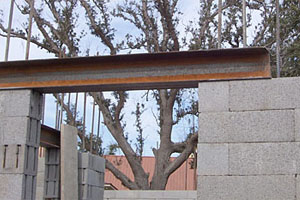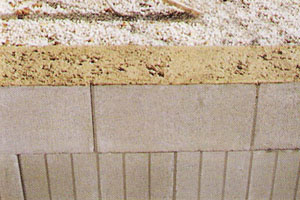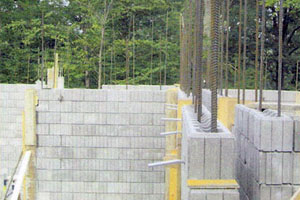Mortarless Masonry: Using Imagination to Revolutionize an Industry
By Dennis Sauve

As most of you know, dry stacking block systems are not new to the U.S. construction industry, but the products' market success has not been stellar for many reasons.
For example, some masonry trades people see these systems as a threat to their livelihood. To this objection I ask, "How many masonry units do they install in a cast-in-place foundation?" Engineers shy away from specifying dry stacking block systems because they view them as new and untested, although reams of data validating the systems' performance in compressive strength, shear and wind loads, to name a few, prove dry stacking blocks' worthiness in many structural designs.
Another reason the systems meet resistance is because the final, constructed appearance often is less than perfect compared with conventional masonry. The reason for this is that varying heights in the base footings and the dry stacking block do not allow much forgiveness.
The intent of this article is not to look at where we have been, but where we can go with this budding building system. Think outside the box, to coin an old phrase, when it comes to dry stacking block systems. First, we must stop thinking of the dry stack block as a traditional concrete masonry unit (CMU) block. In reality, it is a modular and permanent form that can be arranged in fashions to suit the needs of many applications. As long as we look at this system as something to replace conventional masonry block, it will never come close to realizing its full potential.
Imagine if this system could recapture only one fifth of the market lost over the past 20 years ó the numbers would be staggering in their totals.
The beauty of traditional masonry can and will never be replaced. Skilled trades people can embrace this technology as another means to ply their trade in refute of the alternative systems that are truly taking their jobs. We only need a bit of imagination to take this manufactured form and adapt it to the applications of today.
So let's imagine for a moment. The following are just a few ideas on how dry stack masonry can revolutionize the industry:

Imagine using surface bonding products in this new application. Surface bonding of concrete masonry units has been performed for many years and in many applications. It involves the application of a scratch coating of cementitious material that has a fiber mesh imbedded into it while it is still in its fluid form. Once dry, a second coating or parge coating is applied. For structural integrity, this application is applied to both the front and back of the completed wall assembly. If additional strength is required, reinforced detailing in the block core area can be added.
Taking it a step further, we could then apply thin set brick or stone to the finished surface, or add color to the final parging coat. With dry stacking block systems and surface coating products, the appearance of the completed wall is limited only by one's imagination.

Now let's imagine where and how a pre-assembled dry stack block wall may be used.
Basement Walls
Imagine wall panels pre-engineered and assembled at the "factory" arriving to the construction site, dropped in place on a bed of compacted granular stone (depending on soil conditions) and fastened together. Each seam would then be waterproofed and sealed. This is not a new application, if you consider that the precast industry has performed this same technique for years. The difference is the backbone of the system now contains dry stacking block.
Low-rise Construction
Strip malls to residential housing can be erected quickly utilizing the preassembled dry stack block walls that arrive at the job site ready for erection. Shop drawings direct the size and location of each panel ready for mechanical connection. The beauty is that the walls can be pre-finished in color and texture to suit the clients' desires. With the proper wall connections, these walls also can be made loadbearing.
Big Box Construction
As with tip up panels, dry stacking block systems can be produced onsite or in the factory to the specification and corporate identity desired. Erection of the wall uses established techniques similar to precast or tilt-up panels.
These are but a few of the applications that come to mind.
Dry stacking block systems cannot grow on imagination alone. Much has yet to be done with the design and engineering of mechanical connections, testing and promotion to and by our industry leaders and national organizations. The problem is that most new products are proprietary and dry stacking block systems are no exception. The resources of many cannot profit only a few. Maybe it is time to imagine some compromise so all may share in growth products for the benefit of our industry.
About the Author
Dennis Sauve is president of Newblock Corporation in Belle River, Ontario, Canada.


















